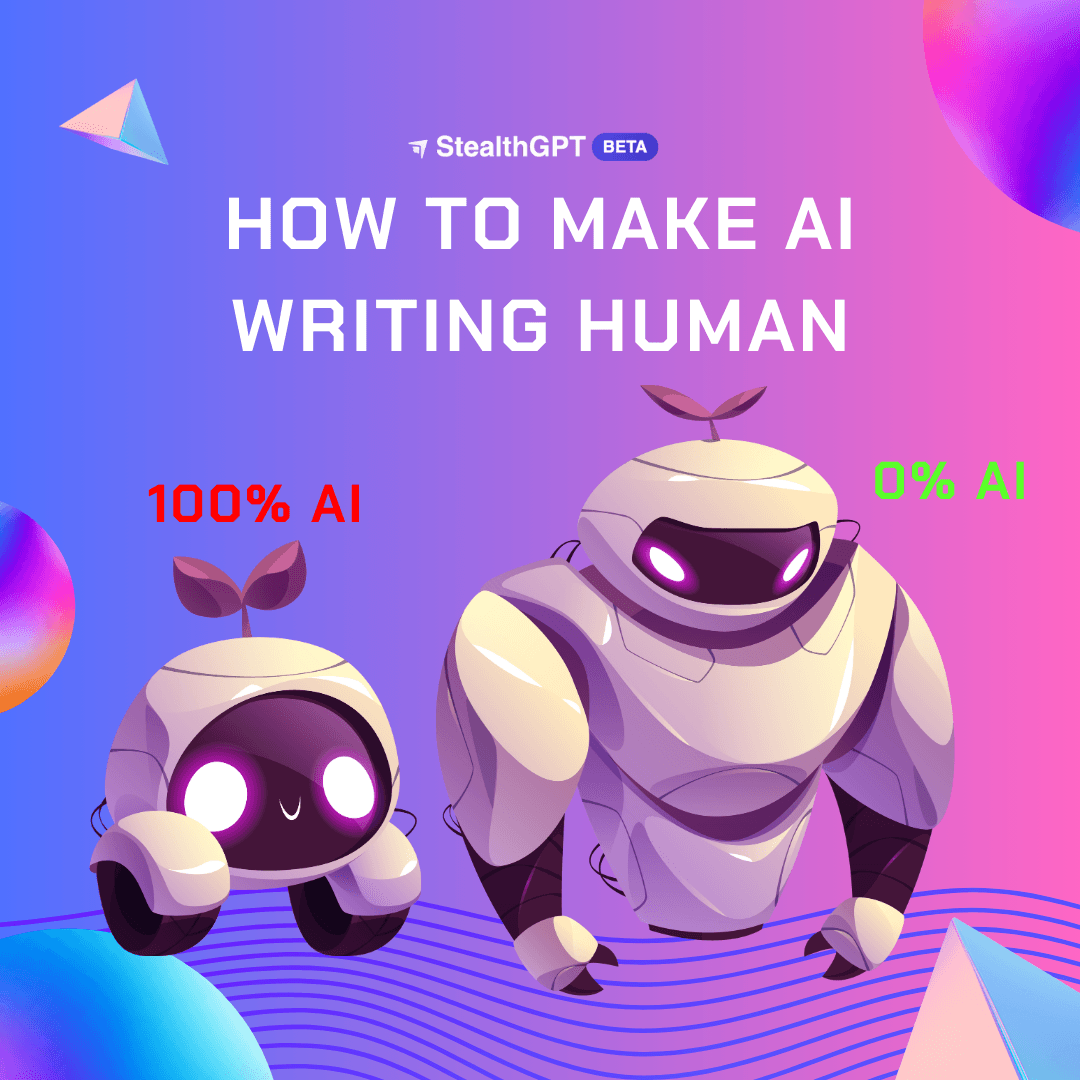Blog, AI Detector
How to Have Zero AI Detection Writing
Are you facing the challenge of creating content that bypasses AI content detectors?
You want to create unique and high-quality content for your essay, article, blog post, or proposal, to name a few, but you do not have the time or big budget to hire a professional writer instead.
So what can you do to beat AI content detection tools at their own game and get several steps ahead?
There is no need to worry.
In today's blog post, we will give you the best tips and tricks on how to outsmart AI writing detection and ensure that your content flies under the radar. So, let’s dive in.
Table of Contents
What Is AI Detection?
How Do AI Content Detectors Work?
Can AI Detectors Identify AI-Generated Content?
Why Bypass AI Content Detection Tools?
Tips and Tricks to Avoid AI Content Detection
In a Nutshell
Frequently Asked Questions
What Is AI Detection?
AI detection refers to the ability of identifying whether a particular input, such as text, pictures, or videos, is generated by an artificial intelligence system. This is achieved by applying different algorithms and methods of analysis to look out for patterns, anomalies, inconsistencies, and other related hints that could indicate AI authorship. This technology can help make sure that the content can be traced back to whether it was human-produced or not.
How Do AI Content Detectors Work?
Typically, AI content detectors use a blend of machine learning algorithms trained from large datasets of human and AI-written text and natural language processing (NLP) to pinpoint characteristics of AI-written text and then compare a piece of text you feed it to what it has learned to return a probability score of how likely it thinks that the text was AI-generated. It’s quite simple, right?
These tools usually pick up on the signs below to tell Whether your text was created by artificial intelligence or not.
Repetitive phrases and sentences
Flawless grammar and spelling
High use of complex and filler words
Overly formal tone
Perplexity and burstiness
Predictable word patterns.
Lack of transitions and casual phrasing
Lack of subjectivity or personal experiences
Inconsistent style and tone
Can AI Detectors Identify AI-Generated Content?
AI detectors will be able to detect AI-generated scripts and will also continue to stay up to date with new developments in AI-generated content. But, they are far from perfect and can sometimes flag genuine human-written texts made by an AI writer. This is called "false positives" and "false negative" results.
Because these tools are based on features of a writing style or language constructions unique to AI-generated content, they are liable to falsely mark human-written articles showing comparable stylistic traces, even when the writer claims it is 100% original as human-written content. So, while the tools are really useful, they are by no means always effective.
Here are some famous AI detection tools that are free to use online to test your writing:
Turnitin
Copyleaks
Content at Scale
Writer
Sapling
Quillbot
GPTZero
Crossplag
Scribbr
After you input your text into their checkbox. Those AI detection tools will typically give a “human score” between 0% and 100%. What it means by that is if your text targets 100 %, it shows that your content could possibly be predicted as AI-writing, and for 0%, it means that your writing style passes as human-written text. The higher the score, the greater the chances that an AI model was employed to generate such text.
Here’s an example. I asked ChatGPT (a chatbot developed by the OpenAI company and launched in November 2022) to “write a short explanation why the Singapore passport is powerful", and here’s the screenshot of what it gave me:
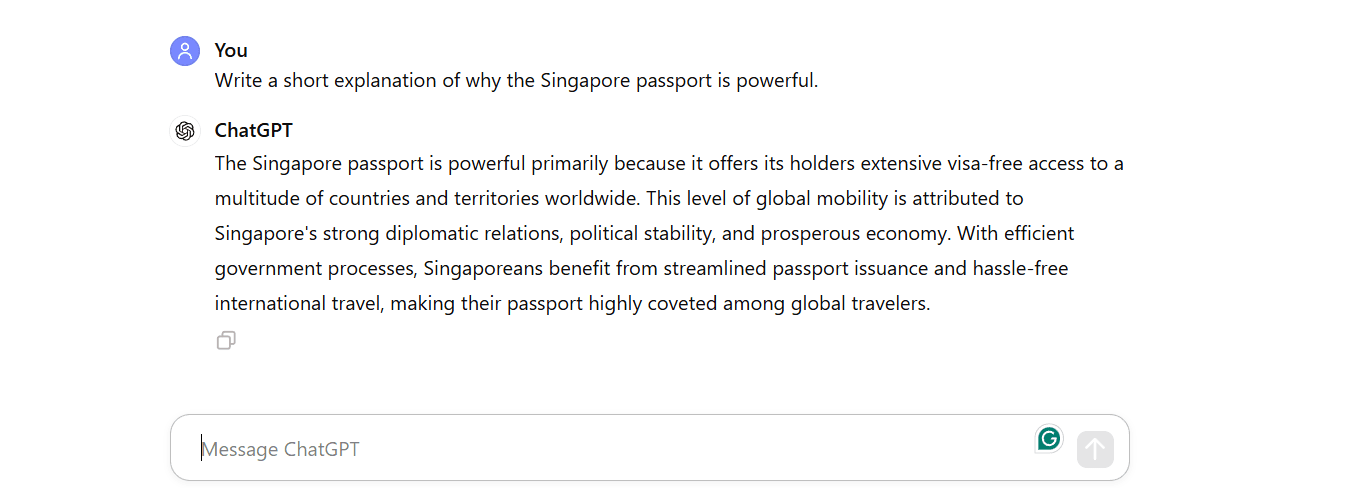
Then, I headed over to one of my favorite AI detection tools which is GPTZero. And the result turned out that it found this content sounds like AI-written content, highlighting all of it as robotic.
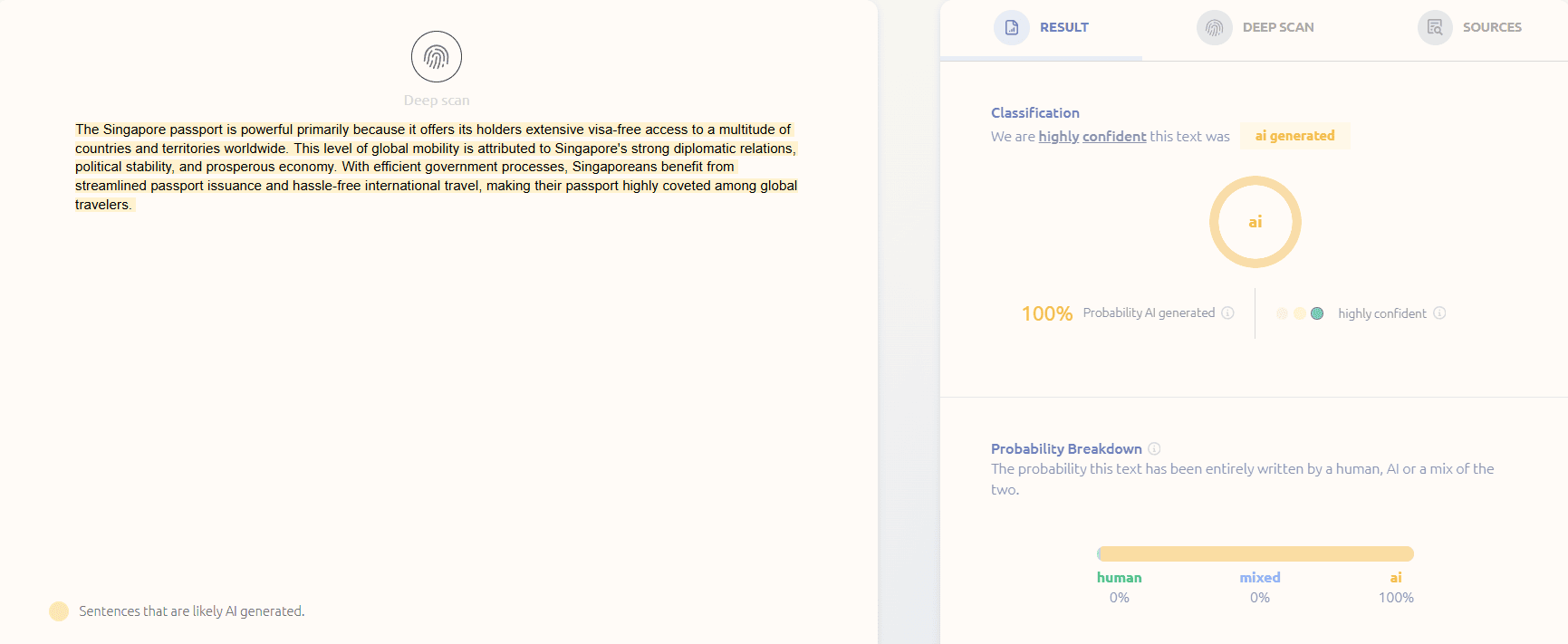
Why Bypass AI Content Detection Tools?
Bypassing AI content detection tools is really important in a digital world like today when the existence of an AI writing tool named ChatGPT first appeared in 2022 has been a game-changer. The world of content writing has never been easier, ChatGPT can be used for writing articles, blog posts, research papers, essays, and more.
However, educational institutions and universities in general also have concerns that this technology will be abused to cheat on academics and exams, as well as ruin the college essay. If students submit AI-generated assignments, they may be considered cheating and violating copyright.
Not only that, students may also lose their ability to think creatively and work independently. So, that is the main reason leading to why they have to leverage Turnitin to catch any students who wish to cheat by using a paraphrasing tool or support from an AI writer.
Besides, Google has also updated its policies that it will put low-quality and spam content away from search engines. This is mainly because Google found that some content writing was created to satisfy only for rank high on search engines instead of focusing on offering the best user experience. At the same time, Medium, a famous and largest platform in the world that allows users to publish articles, stories, and other kinds of content, also announced a policy that it would demonetize and deplatform any AI writing content.
Use our Free AI Detector to check your content
As a result, this is a major problem for writers and SEO professionals who used to rely on AI-generated content like ChatGPT to scale their content creation efforts. It means bypassing AI detectors is a must if people feel that they want to still benefit from the efficiency of AI writing tools in the future.
So, to put it shortly, adjusting your content so that it passes AI detection will definitely help you:
Preventing Google from flagging AI-written content as spam and low-value
Improving SEO performance and ranking on SERPs
Ensuring Originality, high-quality content, and past plagiarism detection
Tips and Tricks to Avoid AI Content Detection
#1. Use StealthGPT, Aka Text Humanizer
StealthGPT could be viewed as an anti-AI detector, or "text humanizer," that rewrites AI content for the purpose of getting over the AI checker. All you have to do is just simply copy and paste your text into the bypass tool, and it will re-process by using new words, eliminating the passive voice, and restructuring sentences to give your content not only a natural and human-like quality but also plagiarism-free.
For example, let’s take our sample essay generated by using Google Gemini and was run through the Stealth Bypass tool, setting “medium” mode as well as “academic” writing tone to rewrite the content.
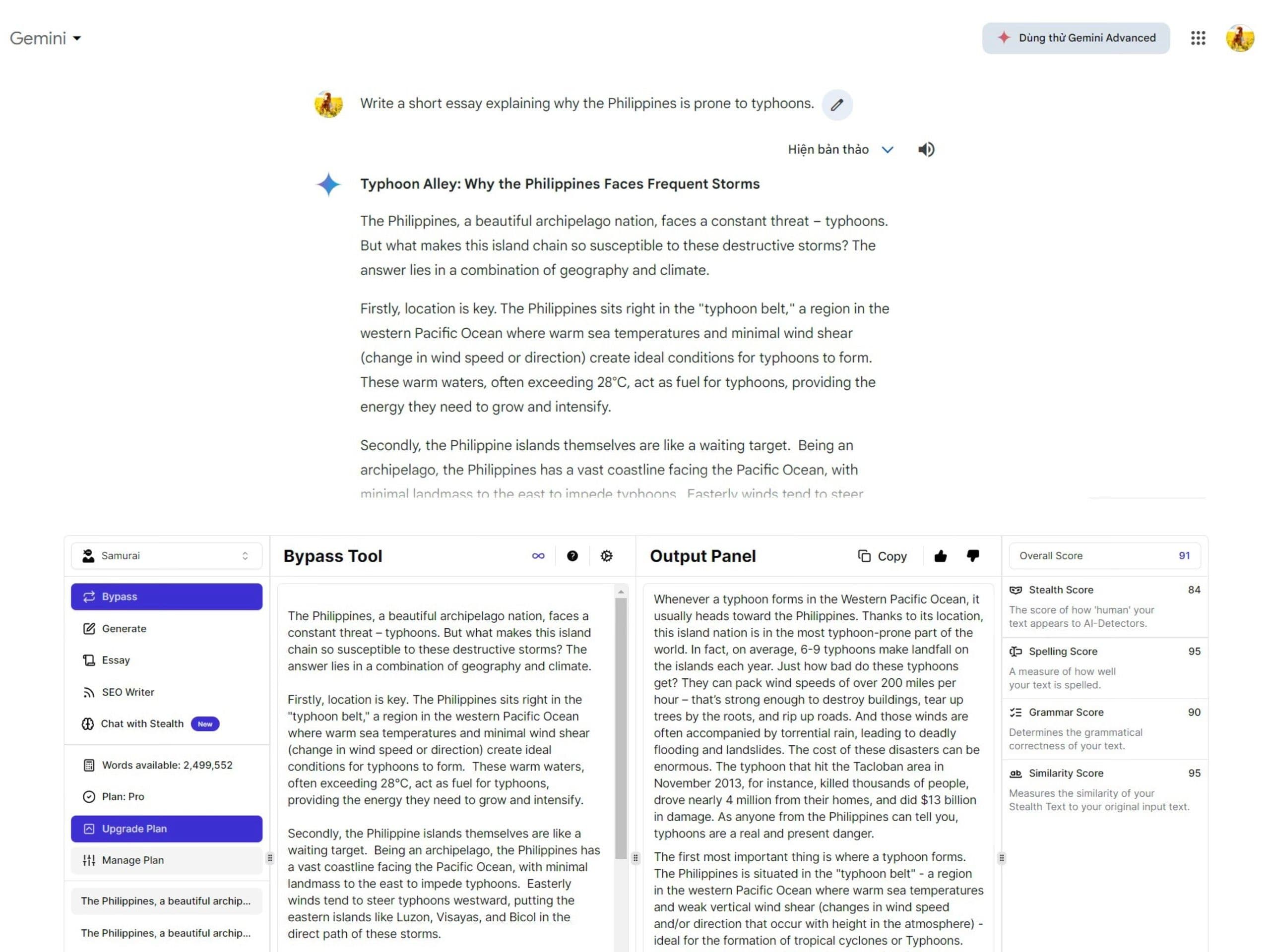
When the AI-written content has been humanized, we just run the new version through a detection tool to see how well it works. In this case, we chose to put it through Originality AI- one of the toughest AI checkers to bypass in the market. Feel free to check out the screenshot below.
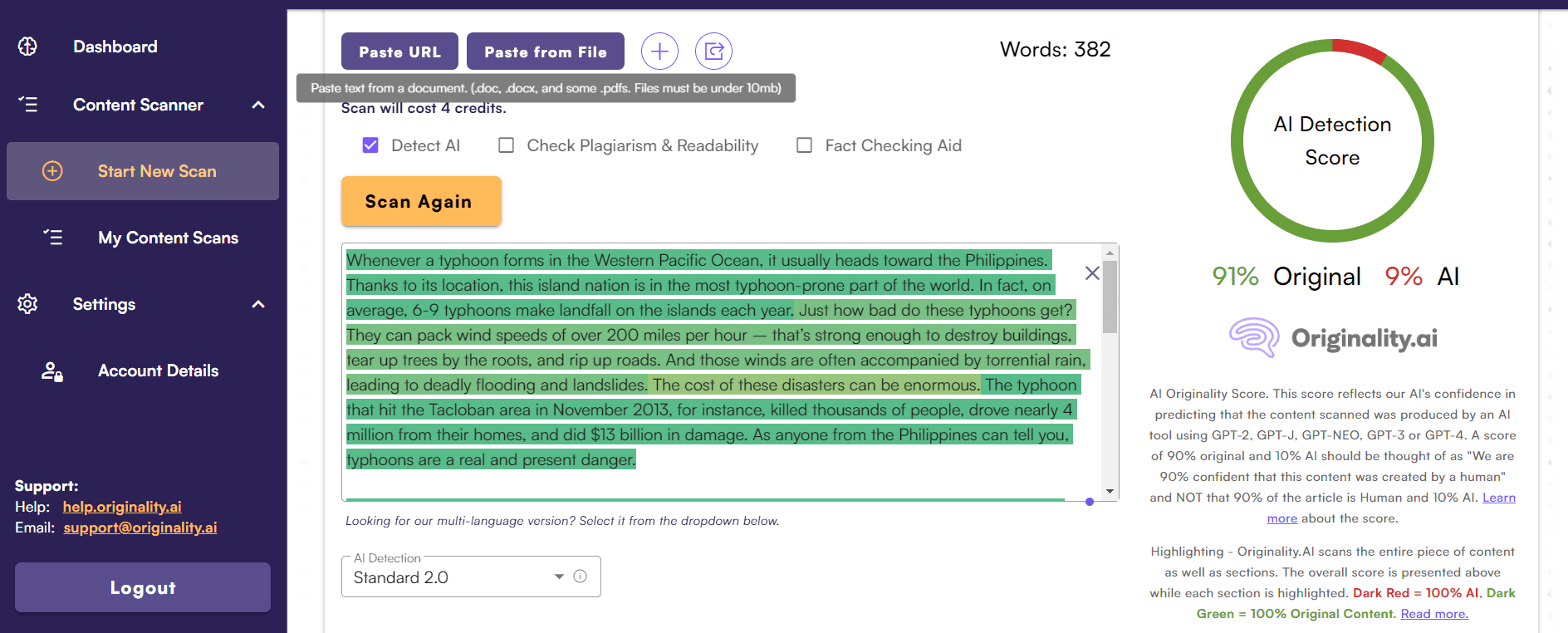
The result is indeed impressive and already speaks for itself; the newly generated content passed 91% as human-written text. That being said, within less than one minute of paraphrasing, the output that StealthGPT provides is not only undetectable but also high-quality.
I have to be honest that this is the most effective, most time-saving, as well as the speediest way to make your text bypass ai detection.
How about the price? We have three different packages for our subscribers, ranging from $17.99 per month to $34.99. It's still cheaper than three cups of bubble tea or coffee that you usually spend on. So, feel free to choose the one that suits you best.
With StealthGPT, not only can you use the AI Bypass tool, but you can also utilize other powerful features such as AI checker, Essay generator, Chat with Stealth, and SEO Writer… at the same time. This Undetectable AI website is proud to provide the best service and price in the industry without compromising the values brought to our customers.
Read more about how well StealthGPT Bypasses AI Detectors
#2. Avoid Repetitive Keywords and Phrases
AI algorithms that can detect whether the text was written by a machine are based on machine learning and natural language. They identify patterns of language repetition and formulaic language.
To prevent this issue, just delete as many keyword repetitions as you can, and by using a more natural tone, you can avoid an overly robotic feel. Here are a few ways to make your writing sound more conversational.
Avoid jargon and complex terms
Ask questions
Provide contextual analysis and deep insight
Embrace Diversity in word choice
Switch up your sentence structure, length, and syntax
#3. Use Synonyms and Similar Words
Another practical tip you can do on how to make AI-generated text undetectable is to incoporate synonyms with similar meanings into your text.
For instance, instead of repeating the same dreadful phrase – ‘avoid AI detection’ – you could run through a list of synonyms to provide variety: ‘avoiding AI classifiers’, ‘slip by AI detection’, ‘evade AI identification’, ‘bypass AI recognition’, ‘elude AI discovery’, ‘dodge AI detection’, and so on. If nothing better springs to mind, you can consult a thesaurus or an online resource to find a suitable synonym for a repetitive term and insert it into every instance.
After synonyms, rewriting for different parts of speech (verb, noun, adjective, etc) or semantically related terms can further humanize AI text. For example, instead of using ‘AI detection’ many times, you could also employ ‘spotting AI-generated text,’ ‘detecting machine authorship,’ ‘flagging artificial intelligence text,’ etc.
But it’s also important to remember not to take this too far because excessive use of frequency synonyms and uncommon or advanced vocabulary is also a marker for AI-content detectors, which can identify phrases that display unnatural stylistic patterns.
#4. Add Personal Touch
The next way that you can try to humanize your content and fool the AI content detection tools is by adding your personal voice and expertise or even telling a story. Because it is totally from you, and there is no record of your experiences existing online to be used as training data.
Showing your knowledge, understanding, and perspective and giving rigorous and logical arguments will make the passage sound more professional and authentic, not sound like a bot-generated. Combining your personal experiences and anecdotes relevant to the topic will make the article more difficult to detect and also increase the diversity of your content.
#5. Use an Active Voice
A lot of AI language models and detectors often rely on patterns to detect writing that is too passive (meaning that the subject is infrequently the doer of the action). So, sticking to an active voice is one way to make AI-generated text sound more human and less robotic and avoid being detected as AI writing.
It is also clear to see that the active voice produces text that is usually easier to read, straightforward, and dynamic. It means that your reader will find it easy to know what’s going on and what your subject is focused on, which makes your content feel more original and authentic, so the words will fly under the AI radar.
For instance, instead of saying
"Jacob Lawson sings the song"
Switch to an active tone
"The song is sung by Jacob Lawson"
Passive voice by itself won’t raise alarm bells that your text was written by a machine or an AI-writing tool, but it might. So, unless you’re writing an intense textbook article where passive voice is more appropriate, avoid using it in your writing.
#6. Use Cyrillic Alphabet
And the next trick I want to mention here is by using "Cyrillic alternatives". Basically, these are symbols that look almost identical to the letters we use every day. So, by replacing letters with Cyrillic alternatives, you can quite literally “cheat” the AI detection tools.

To show you how effective this method is, I will go back to Google Gemini and create a new prompt about “How to overcome depression and anxiety”. Then, I will put the newly produced text into Originality AI to check first.
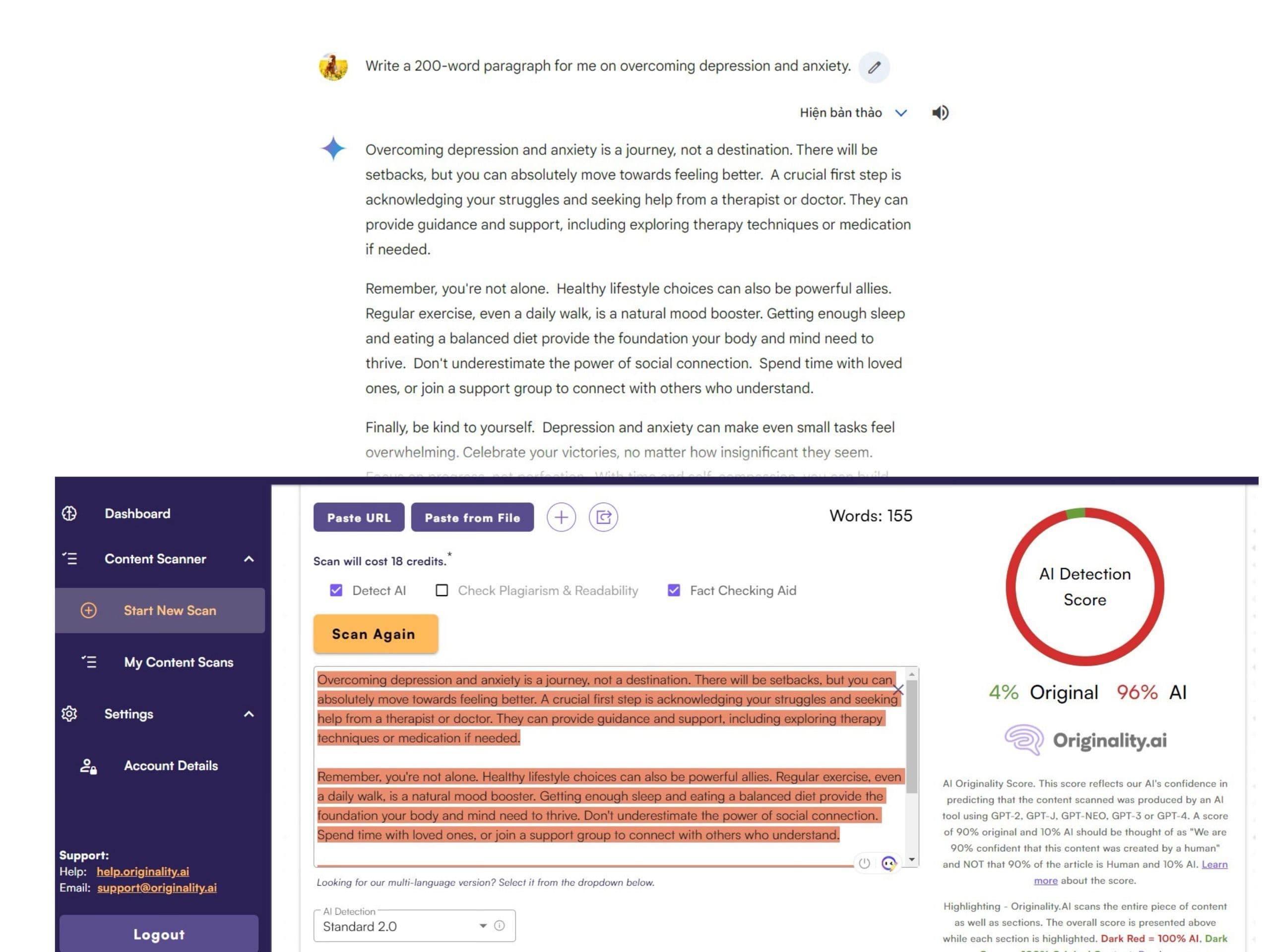
After making sure that the paragraph was flagged as AI-generated scripts. Then, I will use the same content that Gemini gave me and replace some of the normal alphabets with Cyrillic letters. Finally, I will run the scan again with the Originality AI Detector to double-check the result.
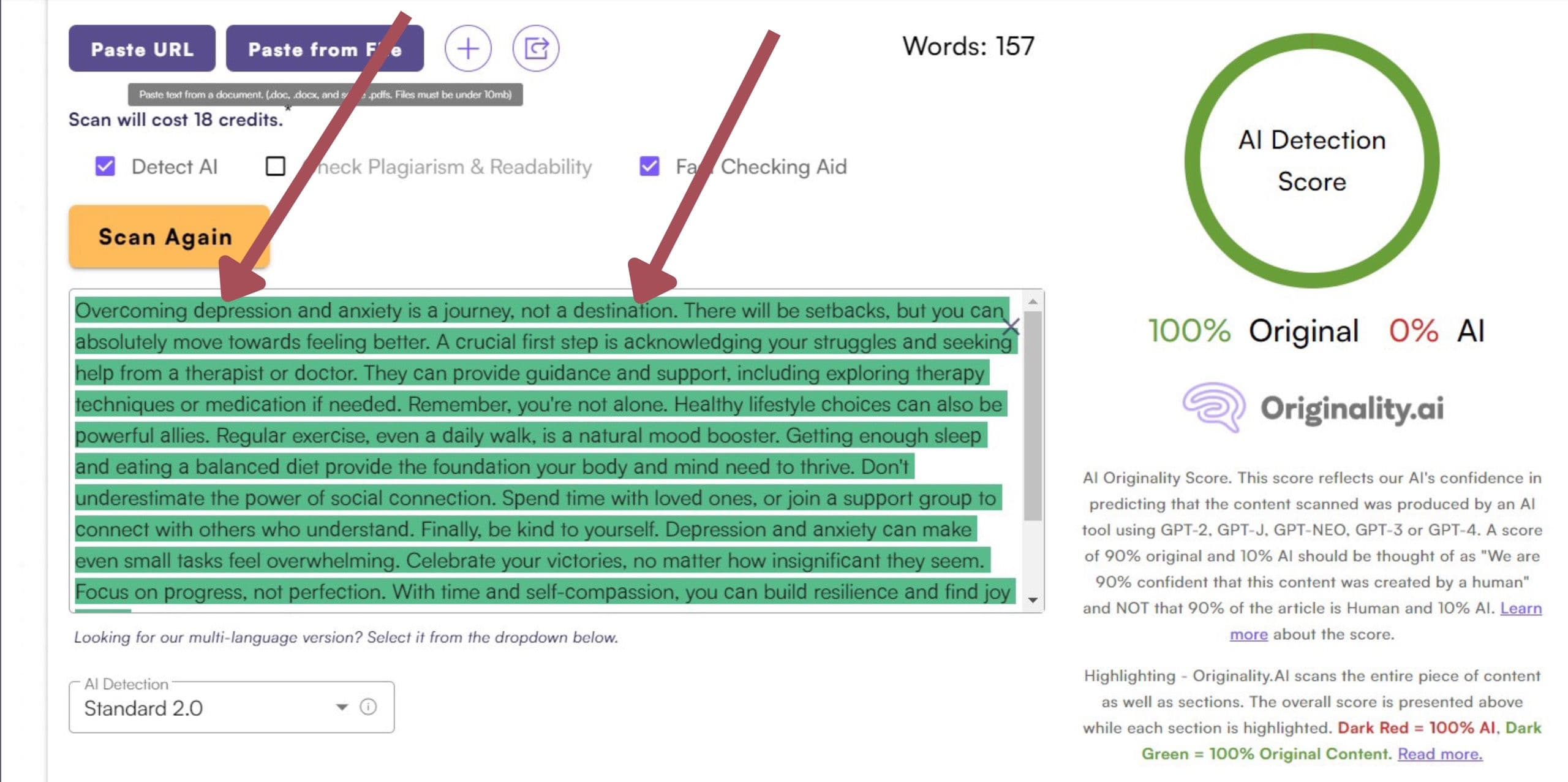
As the screenshot shows, with different letters replaced, the result is so much more impressive. It receives the highest score of 100 percent of human-written content in Originality.ai. And if you could notice, the text was basically unchanged from the original version that Gemini Content provided; in fact, we did not humanize anything or even delete a comma from the AI-generated text.
I just simply replaced some of the letters “A,””C,” "P," and”D” that looked slightly different from the rest. In other words, this could be seen as one of the effective ways to outsmart and fool the AI Detector. However, it takes time to typo everything from scratch and pay close attention to each letter.
Some AI detectors such as Turnitin can detect if the texts use the Cyrillic alphabet by mentioning it in the AI writing score. It's important to take your time and research if this method is worth the risk. The best way is to find an undetectable AI service like StealthGPT to humanize your writing.
#7. Add the ‘Perplexity’ to your AI-written content
Perplexity means measuring the predictability of the sentence, and it is the main material that is required if you want your AI-generated content to be undetectable by AI content detection tools.
For example, if you have a sentence like "She walks with her..." and the next word is a cat, then AI machine learning algorithms guess correctly, which means that the sentence has a low perplexity. This can be predicted because your sentence is easy to forecast. But if you write a sentence like "She walks with...her giraffe" and AI can not know the answer, then your sentence is high perplexity.
So, bear in mind that the more you make your content perplexed, the less it seems as AI-generated. However, just do not overuse single words; you can change how you use punctuation, adjust your typical sentence structure, or alter the spaces between words or lines, for instance.
In a Nutshell
To wrap up, in this blog post, I present arguments on AI content detection, how do AI content detectors work, and whether or not they can detect AI-written content.
Moreover, I also highlight many actionable tips on how to avoid detection of your AI content, including enabling StealthGPT- the best tool to make the AI-generated content more humanlike as well as plagiarism-free, culling repetitive keywords and words, employing synonyms and similar words, adopting an active voice, using Cyrillic alternatives, and adding your personal experiences and perplexity to your writing style.
Can all these techniques make your text truly original and untraceable by AI checkers? Let’s give it a shot to see the real differences.
Frequently Asked Questions
Q1. Can StealthGPT generate original and unique content?
Absolutely, this is because the platform was trained on diverse datasets, and an undetectable engine automatically makes the writing completely different from the original inputs as well as plaragism-free. However, it is important to review and adjust the generated content to match your brand tone and maintain its uniqueness.
Q2. If I use Grammarly for grammar checks, do Turnitin and AI detection tools flag it as AI-written text?
No. The detector is not tuned to target Grammarly-generated spelling, grammar, and punctuation modifications to the content. However, please note that this excludes GrammarlyGo, which is a generative AI writing tool, and as such, content produced using this tool will likely be flagged as AI-generated content by Turnitin or other AI checkers.
Q3. Are there any limitations of AI-generated text?
Of course. These limitations might include the potential for inaccuracies and biases in the text generated and the struggle to maintain its creativity and originality. Another limitation is the possibility that the text may not have the same emotions or feelings as human writers.
Q4. How important is a human editor for AI-generated text?
A human editor is super important to make sure your AI-generated content passes as human writing. Even though an AI writing tool like GPT-4 could produce high-quality content in minutes, it lacks the human elements of feeling and understanding that human writing can bring to the project. A human editor can help to add valuable insights and creativity to the text and tailor it for the right target audience that AI may overlook.
Q5. Can Zero AI detection writing be applied to different types of content?
Sure, you can use zero AI detection writing skills in this blog post for various types of content writing, from academic papers and reports to marketing proposals and so on.
Q6. What are the best free AI content detectors?
The best free AI content detectors are Copyleaks, GPTZero, and Quillbot.
